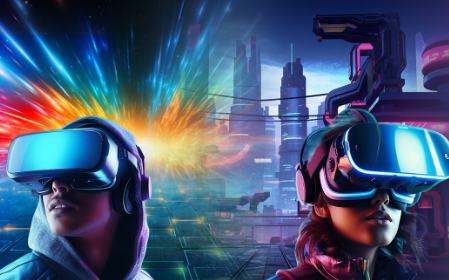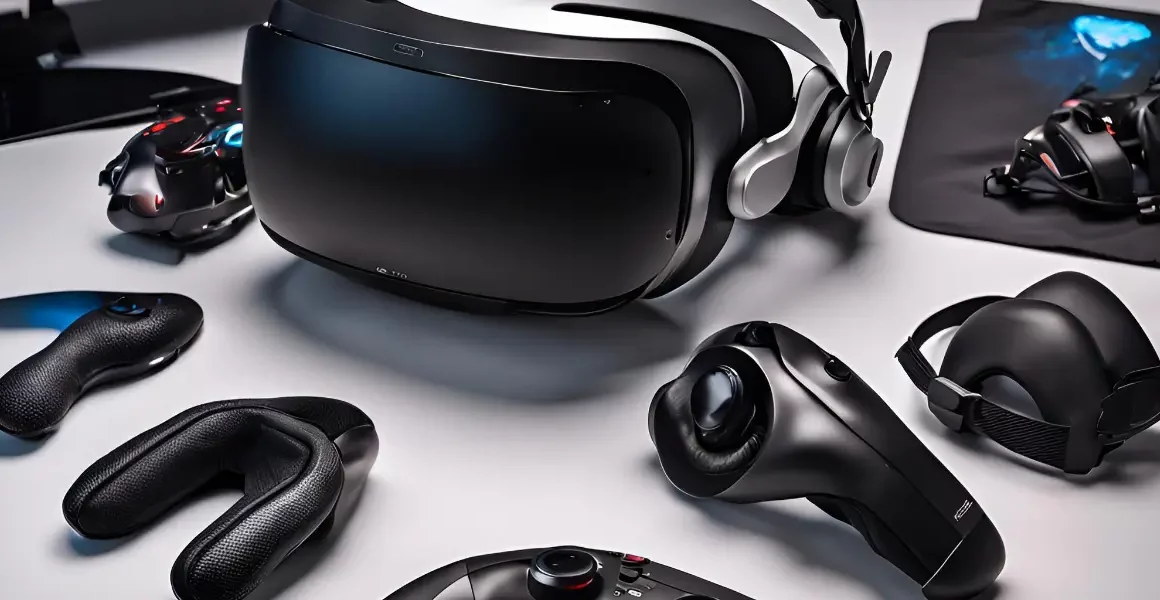In the world of technology, virtual reality (VR) has changed the game. It offers amazing immersive experiences. But, there’s more to VR than just fully immersive worlds. Non-immersive virtual reality lets users explore new realities while still being connected to the real world.
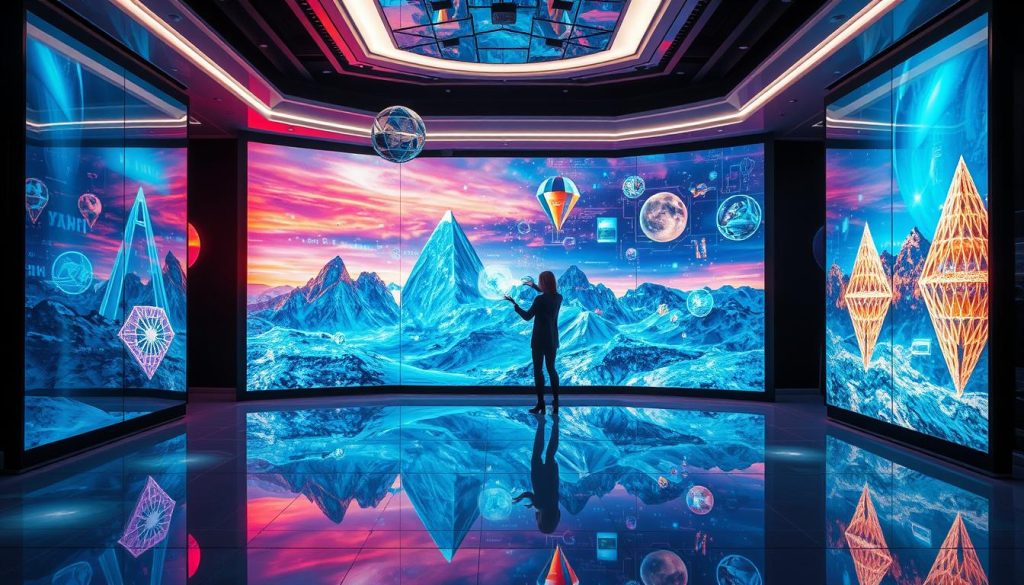
Key Takeaways
- Non-immersive virtual reality offers an enhanced digital experience without fully isolating the user from the physical world.
- This technology is finding applications across various industries, including education, entertainment, and business.
- Non-immersive VR is more cost-effective and accessible compared to its fully immersive counterpart.
- Advancements in technology and integration with other emerging technologies are driving the evolution of non-immersive VR.
- Understanding the benefits and limitations of non-immersive VR is crucial for leveraging its full potential.
What is Non Immersive Virtual Reality?
In the world of virtual reality (VR), there are two main types: immersive and non-immersive. Immersive VR pulls users into a digital world. Non-immersive VR, on the other hand, lets users interact with digital content while still seeing the real world.
Defining the Concept
Non-immersive virtual reality, or “desktop VR,” uses everyday devices like computers, tablets, or smartphones. It lets users explore digital environments but keeps them connected to the real world. This way, users can see and interact with their surroundings while enjoying a virtual experience.
Distinguishing it from Immersive VR
The main difference between non-immersive and immersive VR is how they engage the senses. Immersive VR systems, like special headsets, aim to block out the real world. Non-immersive VR, however, adds digital elements to the real world, making it easier to switch between the two.
Non-immersive virtual reality has its own benefits. It’s more accessible and affordable. It also keeps users connected to the real world. This makes it great for education, training, entertainment, and business.
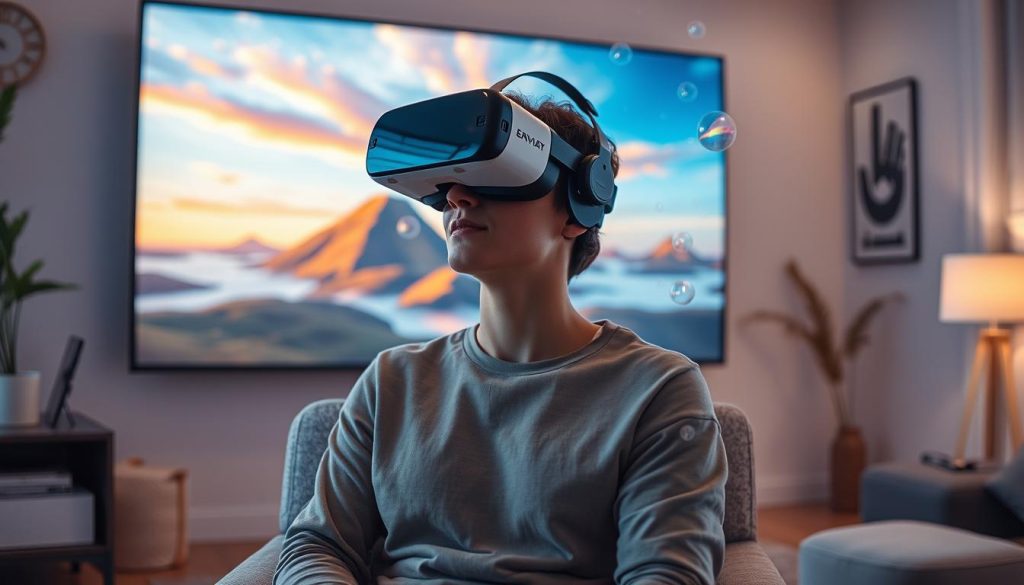
“Non-immersive virtual reality provides a middle ground between the real world and the fully immersive digital environments of traditional VR systems.”
Applications of Non Immersive Virtual Reality
Non-immersive virtual reality has opened up a new world of possibilities. It changes how we interact with digital content and virtual experiences. This technology is used in many fields, from gaming and entertainment to education and business.
In gaming, non-immersive VR lets players enjoy virtual worlds without big headsets or complicated setups. It brings a new level of fun, where users can explore, solve puzzles, and play games in cool virtual spaces.
Non-immersive VR has also made a big impact in education. Teachers can now create virtual learning environments. Students can learn about complex topics, do experiments, and dive into history or science safely in a virtual world.
In the business world, non-immersive VR is great for training and marketing. Companies can use it to train employees on skills like customer service or safety. It also helps businesses show off their products and services with interactive tours and campaigns, giving customers memorable experiences.
| Industry | Non Immersive VR Applications |
|---|---|
| Gaming | Interactive virtual environments, multiplayer experiences, puzzle-solving |
| Education | Virtual simulations, interactive learning, exploration of complex concepts |
| Business | Employee training, product showcasing, virtual tours and exhibitions |
Non-immersive virtual reality keeps expanding what’s possible. It offers many ways to improve our digital lives and open new doors in different fields. As it grows, we’ll see even more creative and impactful uses of non-immersive VR in the future.
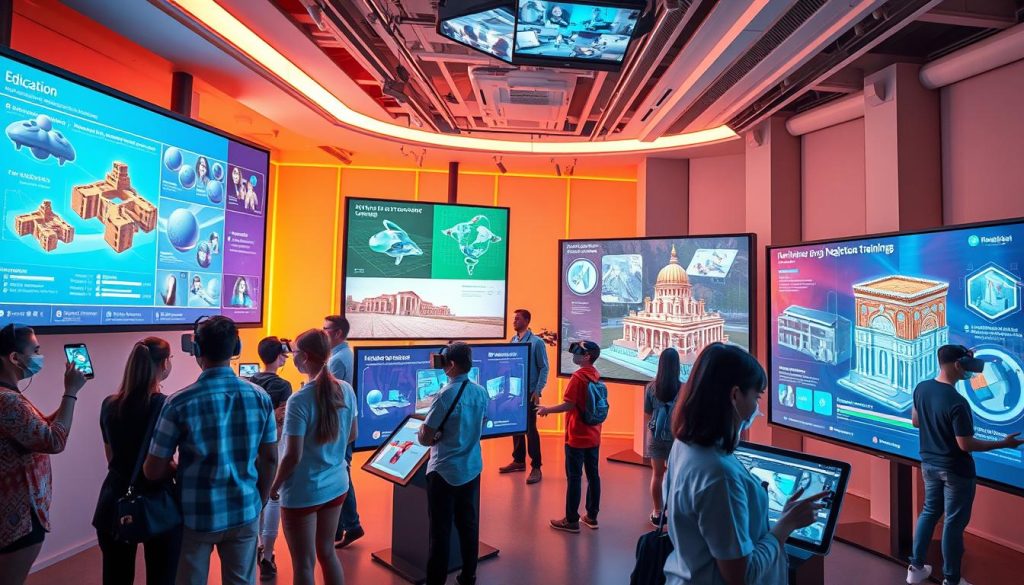
Key Benefits of Non Immersive Virtual Reality
Virtual reality (VR) is getting more popular, and non-immersive VR is leading the way. It’s cheaper and easier to use than fully immersive VR. These VR experiences bring many benefits, making them useful in many areas.
Cost-Effectiveness
Non-immersive VR is very affordable. It doesn’t need expensive hardware like fully immersive VR. Instead, it uses common devices like smartphones and tablets. This makes it accessible to more people, helping more people enjoy VR.
Improved Accessibility
Non-immersive VR is also easier to use. It doesn’t require the same level of tech or physical effort as immersive VR. This means more people can use it, making VR more inclusive.
Thanks to non-immersive VR, we can make VR experiences better and more available. It helps more people enjoy VR, driving its adoption and creating solutions for everyone.
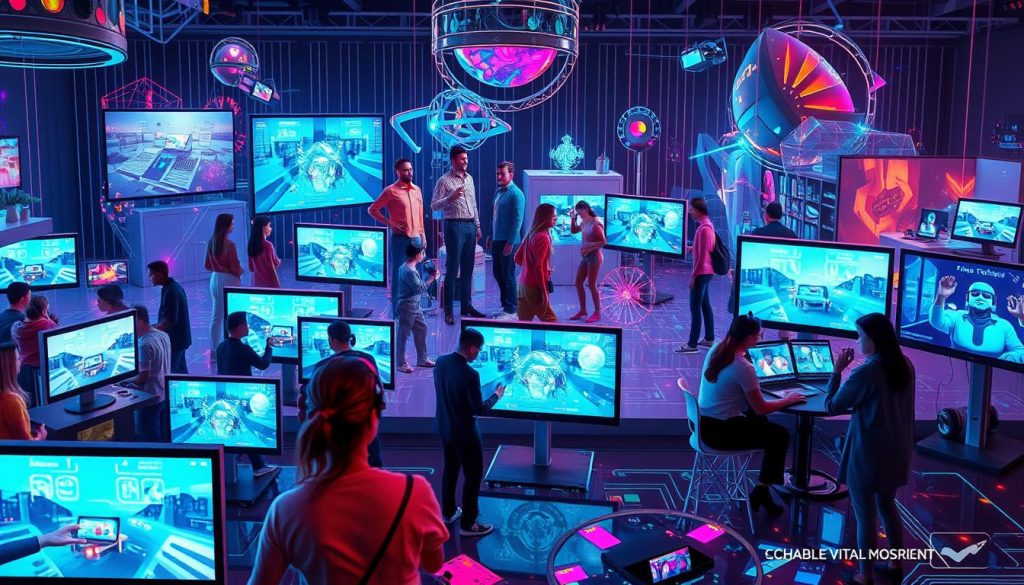
Non Immersive Virtual Reality in Education
Non-immersive virtual reality is changing education in big ways. It makes learning more fun, helps students stay engaged, and supports learning from home. This tech lets students dive into virtual worlds, making learning more interactive and effective.
With non-immersive VR, teachers can take students on virtual field trips and conduct cool science experiments. They can also use 3D models and training simulations. This tech helps students understand complex ideas better and remember them longer.
One great thing about non-immersive virtual learning is how it makes learning fun and interactive educational content. It helps students apply what they learn in real-life situations. This way, they can develop practical skills and solve problems.
Also, non-immersive VR is great for remote learning. It lets students learn from home, which is super helpful when schools can’t meet in person. This flexibility is especially useful during times of crisis or when students are far from school.
In the end, using non-immersive virtual reality in education can really improve learning. It makes learning more engaging and changes how we teach. As tech gets better, we’ll see even more ways VR can help students learn.
| Key Benefits of Non-Immersive VR in Education | Examples |
|---|---|
| Interactive and engaging learning experiences | Virtual field trips, interactive science experiments, 3D models |
| Improved knowledge retention and skill development | Simulation-based training, hands-on learning applications |
| Accessibility and flexibility for remote learning | Virtual classrooms, distance learning programs |

“Non-immersive virtual reality has the power to transform the way we approach education, empowering students to learn, explore, and develop critical skills in innovative and engaging ways.”
Non Immersive Virtual Reality in Entertainment
The entertainment world loves non-immersive virtual reality. It brings many fun and engaging options to us. From games to virtual tours and exhibitions, it changes how we enjoy entertainment.
Gaming Experiences
In gaming, non-immersive virtual reality lets us play with standard devices. No special gear needed. It makes games more fun and real, mixing our world with the digital one.
Virtual Tours and Exhibitions
Non-immersive virtual reality also shines in virtual tours and exhibitions. We can see digital versions of places and shows from home. It’s a cool way to see art, culture, and history without leaving our seats.
| Non Immersive VR in Entertainment | Key Benefits |
|---|---|
| Gaming Experiences | Enhanced user engagement, accessibility, and immersion |
| Virtual Tours and Exhibitions | Expanded access to art, culture, and historical landmarks |
As we keep exploring non-immersive virtual reality, we’ll see more cool experiences. These will mix our real world with the digital one in exciting ways.
Non Immersive Virtual Reality in Business and Marketing
Non-immersive virtual reality is making a big splash in business and marketing. It lets companies create cool virtual product demos and interactive showrooms. These can be accessed easily by customers and clients on their everyday devices.
This tech is great for remote teamwork. Teams can meet in virtual spaces for real-time work. They can share data, documents, and presentations without being in the same place.
It also boosts customer engagement. Companies can give personalized virtual tours of their products or services. This helps customers get to know the company better and feel more connected.
In marketing, non-immersive VR offers new ways to create campaigns. Brands can show off products in interactive demos. This makes customers more interested and informed, leading to better loyalty.
As VR tech gets better, we’ll see more of it in business and marketing. It will bring new ideas, make things more efficient, and focus on the customer.
| Application | Benefits |
|---|---|
| Virtual Product Demonstrations | Enhance customer understanding and engagement |
| Virtual Showrooms | Provide personalized, interactive product exploration |
| Remote Collaboration | Enable seamless teamwork and data visualization |
| Interactive Marketing Campaigns | Foster brand loyalty and informed purchasing decisions |
“Non-immersive virtual reality is transforming the way businesses interact with their customers, driving innovation and enhancing customer engagement.”
Emerging Trends and Innovations
The world of non-immersive virtual reality is always changing. New tech and the mix of different technologies are key. Improvements in displays, software, and how we interact with them are making VR more advanced and easy to use.
Advancements in Technology
Technology keeps getting better, making non-immersive VR more advanced and fun to use. Better displays, faster processors, and new ways to interact are all part of it. Scientists are working hard to make VR feel more real and smooth, using the latest in mixed reality and augmented reality.
Integration with Other Technologies
Non-immersive VR is now working with other cool tech like artificial intelligence and machine learning. This mix is creating new ways to interact and make content smarter. It also lets developers make apps that are more personal and fun for everyone.
As VR keeps getting better, we’ll see even more cool stuff. Keeping up with the latest non immersive virtual reality trends and innovations will help everyone use this tech to its fullest. It’s a great way to find new chances and make things more interesting.
Challenges and Limitations
Non-immersive virtual reality has many benefits, but it also has challenges. Keeping the user experience smooth and engaging is hard. This is because users move between the real and virtual worlds.
Fixing technical issues like hardware and software problems is key for more people to use it. Users need the right devices and software to enjoy non-immersive VR fully. Also, making sure it works well on different platforms and devices is a big challenge.
To keep growing, non-immersive virtual reality needs to tackle these issues. As it gets better, developers and leaders must focus on making it better for users. They also need to make it easier for more people to use it.
FAQ
What is non-immersive virtual reality?
Non-immersive virtual reality lets you experience a virtual world without being fully surrounded by it. You can use devices like computers, tablets, or smartphones. This makes the experience better without cutting you off from the real world.
How does non-immersive virtual reality differ from immersive VR?
Non-immersive VR doesn’t need special headsets to work. It lets you interact with digital content easily. This is different from immersive VR, which requires more equipment to fully immerse you.
What are the key benefits of non-immersive virtual reality?
Non-immersive VR is cheaper and easier to use than immersive VR. It doesn’t need expensive hardware. This makes it more accessible to many people.
How is non-immersive virtual reality used in education?
In education, non-immersive VR is a big help. It offers interactive learning experiences and simulations. This improves learning, keeps students engaged, and supports online learning.
What are the applications of non-immersive virtual reality in entertainment?
Entertainment loves non-immersive VR. It offers interactive games and virtual tours. You can explore digital spaces from your device, making entertainment more fun.
How is non-immersive virtual reality used in business and marketing?
Business and marketing use non-immersive VR a lot. It helps create virtual product demos and showrooms. Customers can access these from their devices. It also helps with remote work and data visualization.
What are the emerging trends and innovations in non-immersive virtual reality?
Non-immersive VR is always getting better. New tech and ideas are coming out. Things like better displays and software are making VR more advanced and easy to use. It’s also being combined with other tech like AR and AI.
What are the challenges and limitations of non-immersive virtual reality?
Non-immersive VR has its own challenges. Keeping the experience smooth and engaging is hard. There are also tech and adoption barriers. Scaling and working across different devices can also be tough.


